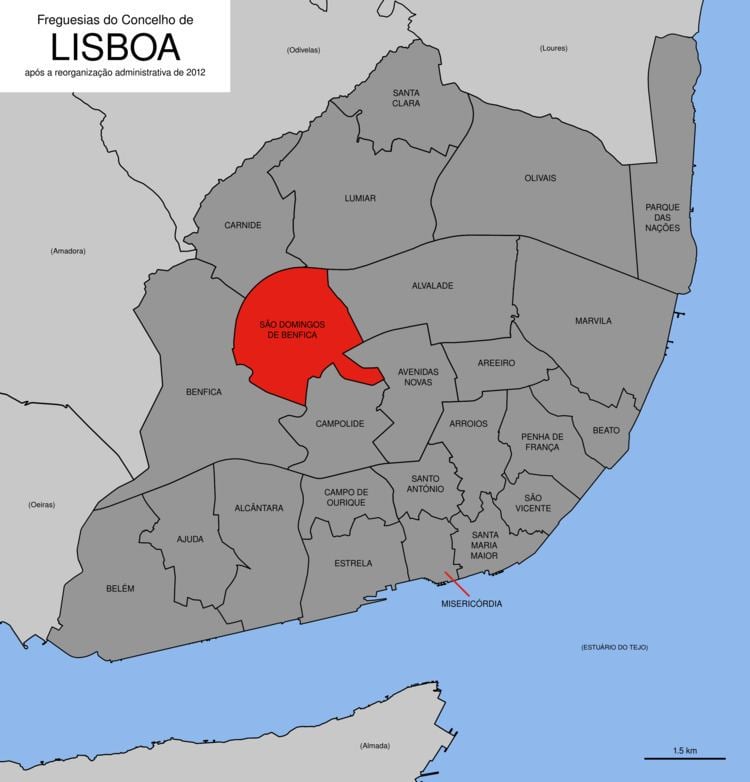Patron São Domingos Population 33,043 (2011) | Subregion Grande Lisboa Municipality Lisbon Area 4.3 km² Postal code 1500 Area code 217 | |
 | ||
Similar São Vicente, Estação Laranjeiras, Palace of the Marquise, Estádio da Luz, Lisbon Zoo | ||
São Domingos de Benfica ([sɐ̃w̃ duˈmĩɡuʃ dɨ bɐ̃ȷ̃ˈfikɐ]) is a Portuguese civil parish, located in the municipality of Lisbon. The population in 2011 was 33,043, in an area of 4.29 km².
Contents
- Map of SC3A3o Domingos de Benfica Portugal
- History
- Geography
- Economy
- Architecture
- Civic
- Religious
- Sport
- References
Map of S%C3%A3o Domingos de Benfica, Portugal
History
It is unclear when people began to settle in the region that would become São Domingos, but may have its basis in the 13th century. A rural subregion, it was less important social-economic centre of Lisbon.
São Domingos de Benfica had its origins in a legend. It was King John I of Portugal who donated it to the Dominican religious order, under the request of João das Regras. Overtime it was in this lands that a palace was erected, later known as the Palace of Benfica (Paço de Benfica), a summer residence of many of the sovereigns since Denis of Portugal. Owing to the legend, King John visited the area, and underscored its natural beauty, affirming: aqui bem-fica o convento (here [is well situated] the convent). The settlement of Benfica was a privileged location with access to water and situated in a forested cover, that highlighted the natural characteristics of Lisbon.
The administrative borders of the parish of São Domingos de Benfica, were delimited by decree law 42/142 on 7 February 1959.
During the 17th century, the territory of São Domingos de Benfica was sought after by aristocratic families to construct palaces and estates, that included orchards, vegetable and flower gardens.
A new period of evolution occurred in the 18th century, when wetlands were converted into arable land, and these lands were apportioned for agriculture. Following the 1755 earthquake many of these estates were permanently occupied by property-owners escaping from the desolation in Lisbon. As a result many of summer/recreational residences were converted to residences. With the growth in demography, the area of Benfica by the 19th century began to be served by public transport: the creation of the Estrada da Circunvalação in 1852, allowed the establishment of new city limits. Consequently, the territory of the new parish of São Domingos de Benfica became integrated into the municipality of Belém, and until this municipality was extinguished in 1885. The creation of the military road and Lisbon-Sintra railway line in 1885; the opening of the electric trams, in 1929, then bus lines in 1985, allowed the expansion of the metropolitan region until Sete-Rios, and made the parish one of the more popular settlements.
Geography
São Domingos de Benfica is a large urban area and settlement that extends from Sete Rios in the direction of Benfica and to the western edge of the Monsanto Park, along the road from Luz and Laranjeiras. The parish is delimited by other six civil parishes of Lisbon: Benfica, Carnide, Lumiar, Alvalade, Avenidas Novas and Campolide.
Economy
Tourism constitutes the primary industry, with a significant importance in the economic activity of the parish's society. São Domingos de Benfica is one of the more cosmopolitan and most populous parishes of Lisbon, constituting an vital touristic polo that differentiates it from other parishes.
Architecture
São Domingos, owing to its settled age, is characterized by a propensity of historic properties, that have been responsible for attracting tourism to the center of Lisbon.
Civic
Religious
Sport
The Estádio da Luz, the stadium of S.L. Benfica, is located within São Domingos de Benfica; until São Domingos was split-off from Benfica, the club represented most of the territory, but this changed with the 1959 de-annexation and creation of São Domingos.
